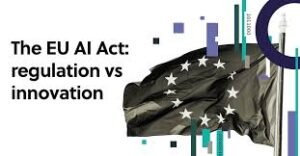The Impact of AI and EU Regulations on Digital Transformation
Digital transformation is no longer just about technology. Organizations today face a dual challenge: innovating with AI while also complying with increasingly strict EU regulations such as CSRD, CSDDD, and the AI Act. Those who manage to balance both can not only reduce risks but also unlock new value.
AI as a Transformation Accelerator
AI has rapidly become mainstream. Companies are using AI tools for customer interaction, data analysis, supply chain optimization, and marketing automation. Yet the true power of AI goes much further:
- Faster decision-making: simulating scenarios, prioritizing portfolios, and accelerating investment choices.
- Operational efficiency: automating repetitive work and freeing up teams for innovation.
- New business models: from predictive maintenance in the energy sector to hyper-personalized e-commerce journeys.
The challenge? Without a clear strategy, AI often remains a set of isolated experiments. The key is to embed AI across the transformation roadmap and tie it directly to measurable business outcomes.
European Regulations as a Game Changer
Alongside AI innovation, organizations face a wave of strict EU regulations from Brussels:
- CSRD (Corporate Sustainability Reporting Directive) → detailed ESG reporting obligations.
- CSDDD (Corporate Sustainability Due Diligence Directive) → requires companies to monitor their full supply chain for human rights and environmental impact.
- AI Act → classifies AI systems by risk level and enforces transparency, data governance, and ethical use.
At first glance, this feels like added pressure. But for companies that structure their processes, data, and IT landscapes effectively, compliance can become a source of competitive advantage.
 The Tension: Speed vs. Compliance
The Tension: Speed vs. Compliance
Here lies the paradox:
- Business demands speed → launching new features, markets, and AI use cases.
- Regulators demand control → robust data quality, governance, and accountability.
Many organizations struggle to reconcile the two. Transformation slows down, or AI initiatives are blocked because compliance hasn’t been embedded. The result: lost opportunities and increased risk.
From Budget- to Value-Driven Choices
The answer lies in portfolio management. Instead of focusing only on budgets or isolated initiatives, decisions should be guided by:
- Value: which projects deliver the highest strategic and sustainable impact?
- Risk: does the initiative align with AI and ESG requirements?
- Capacity: do we have the right people and resources in place?
By including AI-readiness and compliance as decision criteria, organizations create a transparent framework. In this way, digital transformation is not slowed down by regulations — but accelerated by focus and clarity.
Practical Steps for Organizations
- Assess: map out where AI is already in use and where CSRD/CSDDD requirements hit hardest.
- Integrate: embed compliance requirements directly into your transformation roadmap.
- Prioritize: apply portfolio management to choose initiatives that balance value and risk.
- Monitor: use dashboards that show both business impact and compliance status.
- Engage: involve stakeholders early — from the boardroom to auditors and regulators.
Conclusion The Impact of AI and EU Regulations on Digital Transformation: The Future is Integrated
Digital transformation in 2025 is about more than technology. The winners will be those who can leverage AI intelligently while also embracing EU regulation as an opportunity. Rather than treating compliance as a constraint, leading organizations will see it as a catalyst for sustainable growth.
At Oosterwal Consultancy, we believe that complexity can always be simplified into clear, value-driven choices. Through portfolio management, we help organizations shift from budget-driven to value-driven transformation — ensuring AI and compliance work together to deliver measurable results.


